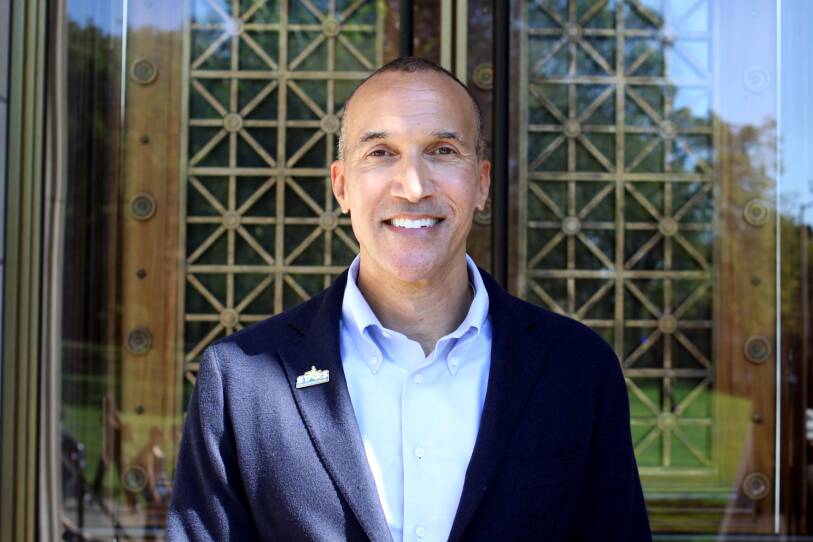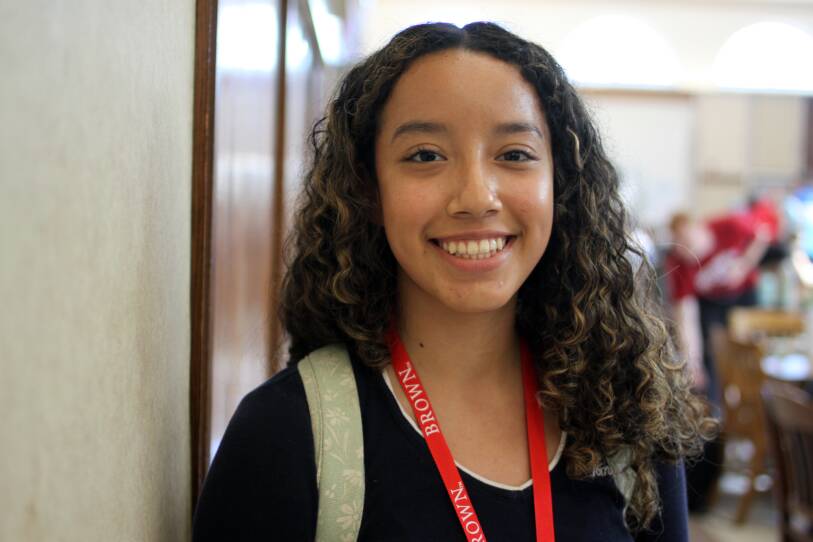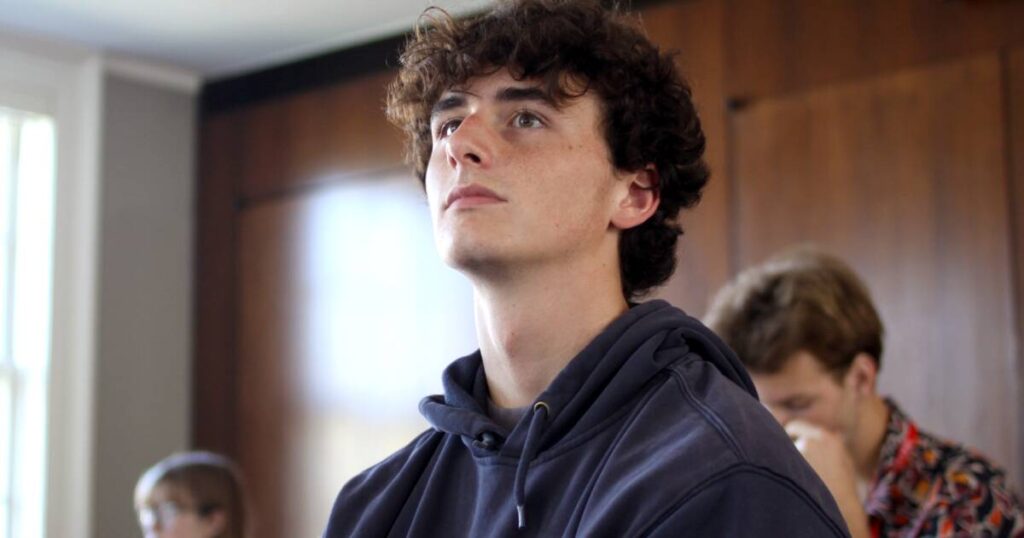Inside a chandelier-lit dining hall at Brown University, 30 high school students from small towns scattered across the country swapped stories about getting their driver’s licenses, plans for after graduation, video games and Taylor Swift’s new album, The Life of a Showgirl. Later, the students observed classes, took a tour, and slept in dorms — all to picture themselves at a school like Brown.
These rural students were part of a three-day “fly-in,” a growing recruitment effort more top colleges are using to broaden their applicant pools. The goal? Enroll more domestic students while increasing the diversity of viewpoints on campus.
“I’ve never been to the Northeast or any New England area,” Clancey VanOort, a senior from Clarence, Iowa, said after taking a tour of the school established in 1764. “There’s just so much history here. It’s not really a thing in Iowa. The fact that it was founded before the country was founded is just crazy.”
About 20% of Americans live in rural areas. But they are less likely than their suburban and urban peers to attend college, and among those who do, most stay within 25 miles of home. Decades of state funding cuts have only deepened the enrollment divide, hitting rural campuses hardest and limiting local options.
“Serving the entire United States, not just the big cities, is really important,” said Marjorie Betley, executive director of the Small Town and Rural Students College Network, an organization that supports colleges’ outreach efforts. Since launching in 2023, the nonprofit has doubled in size — now working with 32 schools, including Brown, MIT, Dartmouth and Spelman.
Demand from students has also soared. Applications for fly-in programs like the one hosted at Brown jumped from 250 last year to 1,700 this fall. Northwestern University is reporting 30% growth in its enrolled rural and small-town students due to continued support and collaboration. Brown is reporting an 18% bump in first-year students from small towns.
Looking broadly across the country, though, Betley said American higher education isn’t doing enough. She gives most colleges a C-minus for enrolling and supporting rural students.
“There are quite a few schools that have never even considered their rural populations,” she said. “Not only how they enroll them, but also how they support them on their campuses once they get there.”
UMass Amherst, for example, which is not a member of the Small Town and Rural Students College Network, told GBH News it tracks what high schools students come from in each entering class, but not the designation of which are rural or small-town. A spokesperson for Boston University, the largest private school in New England, said it does not track rural and small-town student enrollment data.

Kirk Carapezza
GBH News
For VanOort, the high school senior from Clarence, Iowa (population: 1,039), visiting Brown in Providence was surreal and eye-opening. Three generations of his family have attended Iowa State, about two hours by car from the cornfields of Clarence. Ivy League schools like Brown, he said, “just don’t seem accessible from Iowa.”
Kai Thoma said there are limited higher education opportunities near where she grew up in Osceola Mills, Pennsylvania (population: 1,045), and most of her classmates enroll in vocational education. She said there’s “resentment” in her town among those who believe the government and higher education institutions want to keep underprivileged people down.
“We want our voices to get out there,” she said. “We need the opportunities too.”
For Logan Powell, Brown’s dean of undergraduate admissions, recruiting rural students like VanOort and Thoma isn’t just about numbers, it’s also about improving national unity and bridging political and social differences.
“We’re doing this because we think it’s the right thing to do,” he said, sitting in the dining hall. “Bringing students together from these dramatically different backgrounds, giving them a chance to talk to each other, this is exactly what’s, I think, so wrong with what we observe happening in the country right now.”
These efforts come as the Trump administration pressures colleges to enroll more U.S. students and diversify viewpoints on campuses. Earlier this month, the administration sent Brown and eight other colleges a list of demands in exchange for easier access to federal research dollars. Among them: freeze tuition for five years and cap international enrollment at 15%.
Experts say schools like Brown, Dartmouth and MIT were likely chosen because they’re seen as “good actors.” Brown already signed a similar agreement earlier this year to unfreeze millions in research dollars, committing to certain policy changes and making a $50 million investment in Rhode Island workforce development organizations.
Last week, Brown President Christina H. Paxson refused to sign the compact, asserting that the school’s prior agreement with the government preserved Brown’s core values “in ways that the Compact — in any form — fundamentally would not.” Paxson said the proposal would undermine the university’s autonomy and academic freedom.
Earlier this month, MIT was the first university to reject signing the compact. In a letter to the government, MIT President Sally Kornbluth wrote: “America’s leadership in science and innovation depends on independent thinking and open competition for excellence.”
A spokesperson for MIT told GBH News that the number of rural students at the university has increased each year since the university began participating in the STARS College Network back in 2023, but the university would not provide specific data points.
At Brown, rural student enrollment has increased from 5% of the incoming class five years ago to 8% of the latest class.

Kirk Carapezza
GBH News
At Brown’s fly-in event, admissions officials also make sure to talk about money since many Americans see college as unaffordable. Toward the end of the three-day trip, students attend a financial aid session where they learn about scholarships and grants to cover the full cost of attendance for families earning less than $60,000 a year and with assets less than $100,000.
That’s welcome news for Thoma, the student from Pennsylvania. Her mom is disabled and takes care of her great-grandmother, so her family relies on Supplemental Security Income.
“If you do the research, there are so many opportunities out there for you,” she said. “It doesn’t really matter where you come from, your financial situation. Programs like this, they want you to succeed.”
Genesis Nunez is low-income, the daughter of a homemaker and construction worker. She describes her hometown of Newman, California (population: 12,351) as “vibrant” and “tight-knit” but says selective colleges like Brown can feel distant and unaffordable, like they’re on another planet.
“There’s only so much that you can learn from the website,” she said. “I thought Brown was just nerdy and geeky and people are so locked in. But I actually got to see people pie-ing each other in the face for a sorority thing, and it’s just so fun here.”
This fall, Nunez plans to apply. She hopes to become the first in her family to go to college — and perhaps join a sorority.

